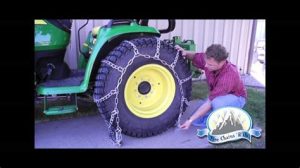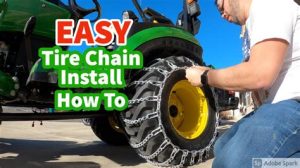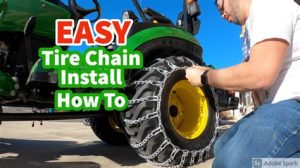Discover essential insights on chain security, types of tractor tire chains, installation techniques, grip factors, and maintenance tips for extended longevity.When tackling challenging terrain, ensuring your tractor tires have maximum grip is essential, and one often overlooked solution is the use of tire chains. These robust tools not only enhance traction but also provide stability and safety in adverse conditions. In this blog post, we’ll delve into the importance of securing chains on your tractor tires to optimize performance. From understanding different types of chains suited for various applications to mastering proper installation techniques, we’ll cover all the essentials. Additionally, we’ll explore key factors that contribute to maintaining that all-important grip and share valuable maintenance tips to extend the life of your chains. By the end, you’ll be equipped with the knowledge to improve your tractor’s performance and tackle the toughest tasks with confidence.
Understanding the Importance of Chain Security
When it comes to operating tractors in challenging conditions, chain security is paramount. Chains provide essential grip on slippery surfaces, ensuring the safety and efficiency of the machine. Without proper security measures, chains can slip or break, leading to costly downtime and potential accidents.
One of the main reasons to understand the nuances of chain security is the variability of terrain. Whether dealing with muddy fields or icy roads, knowing that your chains are secure can significantly affect your work performance. Using quality chains designed specifically for your tires not only enhances the grip but also prolongs the life of both your chains and tires.
Furthermore, proper chain security can prevent wear and tear on your machinery. Loose or improperly fitted chains can cause vibrations or damage to the tractor itself. This not only results in unexpected repair costs but can also lead to unsafe operating conditions.
| Benefits of Chain Security | Description |
|---|---|
| Enhanced Safety | Reducing the risk of slipping or losing control. |
| Improved Efficiency | Ensuring optimal performance in adverse conditions. |
| Extended Equipment Life | Preventing unnecessary wear on tires and machinery. |
Types of Chains for Tractor Tires
When it comes to enhancing traction and ensuring safety while working in challenging terrains, selecting the right chains for tractor tires is crucial. Various types of chains offer distinct advantages based on their design and application.
| Type of Chain | Description | Best Used For |
|---|---|---|
| Link Chains | Made of interconnected links, these chains provide robust traction. | General purpose and rugged terrain. |
| Cross Chains | Feature cross members that enhance grip and stability. | Soft and slippery surfaces. |
| Diamond Chains | Designed in a diamond pattern to maximize surface contact. | Heavy-duty work and icy conditions. |
| Rubber Chains | Made of rubber with metal inserts for added grip without damaging tires. | Use on asphalt and delicate surfaces. |
Choosing the right type of chain is essential for maximizing grip and ensuring the efficiency of your tractor operation. Link chains may be ideal for general-purpose use but may not provide the grip needed for steep inclines or slippery roads. On the other hand, diamond chains offer better traction on ice, making them suitable for winter conditions.
Furthermore, cross chains can significantly improve vehicle control, especially in muddy or loose terrain. It’s crucial to assess your specific needs based on terrain, load, and intended use to make the most informed choice.
Ultimately, the key is to select a chain that enhances your tractor’s performance while offering the safety and durability required for the tasks at hand. Ensuring you have the right chains can prevent accidents and promote efficient operation in all working conditions.
Proper Installation Techniques
Installing chains on your tractor tires is crucial for ensuring maximum grip and safety while operating in various terrains. To achieve this, understanding the right installation techniques is essential.
- Choose the Right Size: Before installing, it’s important to have the correct chain size that fits your tractor tires perfectly. Measure your tire’s width and diameter.
- Lay Out the Chains: Begin by laying the chains flat on the ground, ensuring there are no twists or tangles. This will facilitate easier installation.
- Position the Chains: Gently place the chain over the tire, starting from the top and allowing it to drape down the sides. Make sure that the cross-links are aligned properly.
- Secure the Chains: Use the appropriate tensioning system to tighten the chains around the tires. Adjust the chains so there’s an even distribution of tension, which will prevent slipping during operation.
- Check and Adjust: After securing, drive a short distance and then stop to recheck the tension of the chains. Readjust as necessary to ensure they are tight and securely in place.
The key to effective grip lies in the proper installation of chains. Ensure every step is performed with care and diligence.
In addition to these tips, always refer to the manufacturer’s guidelines for specific recommendations related to your unique chains and tire types. This will ensure you get the best performance from your equipment.
Regular checks and maintenance of the chains post-installation are also recommended to prevent wear and tear. Make it a habit to inspect your chains before and after use, especially during the peak operating seasons.
By following these installation techniques, you’ll enhance the performance of your tractor, allowing for better traction, stability, and control as you navigate challenging surfaces.
Factors to Consider for Maximum Grip
When it comes to securing chains on tractor tires, achieving maximum grip is essential for optimal performance, especially in challenging conditions. Understanding the various factors that influence grip can help ensure that your chains work effectively. Here are some of the key considerations.
- Tire Types: Different types of tires, such as agricultural or industrial, may require specific chain styles. Ensure you select chains that are appropriate for your tire type to achieve maximum grip.
- Chain Size: The size of the chain must match the size of the tire. Mismatched chains can lead to ineffective grip or even damage. Always refer to the manufacturer’s specifications.
- Link Design: The design of the chain links affects how well they grip the surface. Chains with a more aggressive link design provide better traction on slippery or uneven terrain.
- Tensioning: Properly tensioned chains are crucial for effectiveness. Chains that are too loose can slip and reduce grip, while overly tight chains can wear out quickly or damage the tires.
- Weather Conditions: The type of surface you will be operating on—whether it’s snow, mud, or ice—should influence your choice of chains. Different conditions may require different chain configurations for optimal grip.
Additionally, consider the installation technique you employ. Proper installation can significantly impact the performance of the chains. Make sure to follow installation guidelines closely and check the chains regularly for wear and tear.
Regular maintenance of the chains will also ensure they remain effective over time. Inspect for rust, damage, and wear, and clean them to prevent debris buildup. Keeping the chains in good condition will directly correlate to the grip they provide.
Maintenance Tips for Longevity
To ensure the longevity of your tractor tire chains, it is crucial to incorporate regular maintenance practices. Proper care can greatly enhance the performance and life of your chains, which in turn improves their grip and effectiveness on challenging terrains.
- Regular Inspection: Frequently check your tire chains for any signs of wear and tear. Look for broken links, rust, or any other visible damage that may impair functionality.
- Cleaning: After each use, clean the chains to remove mud, dirt, and debris. This prevents rust and maintains the integrity of the metal.
- Proper Storage: Store your chains in a dry place to avoid moisture accumulation. Consider using a protective cover to shield them from dust and humidity.
Additionally, applying a light coat of lubricant to the chains can help reduce friction and prevent rust. When it comes to maintaining tractor tire chains, consistency is key. With diligent maintenance, you can achieve maximum grip and ensure that your chains serve you well for many seasons to come.
Frequently Asked Questions
Why is it important to secure chains on tractor tires?
Securing chains on tractor tires is crucial for maximizing grip and traction, especially in slippery or uneven terrains, which enhances safety and efficiency during operations.
What are the steps to properly install tire chains?
To properly install tire chains, start by laying the chains flat, draping them over the tire, securing the ends, and then tightening them according to the manufacturer’s instructions.
What tools do I need to secure chains on tractor tires?
You typically need a pair of gloves for protection, a chain tensioner, and possibly a wrench for tightening the connections, depending on the type of chains.
Can I use any type of chains for my tractor tires?
No, it’s important to use tire chains specifically designed for tractors, as they are optimized for the weight, size, and usage conditions of agricultural equipment.
How often should I check the chain tension once installed?
You should check the chain tension after the first hour of use, and then periodically throughout operation, especially after driving on rough terrain.
What safety precautions should I take when installing tire chains?
Ensure the tractor is on a stable surface, wear gloves to avoid injuries, and be cautious of pinch points when handling the heavy chains.
Are there any alternatives to using chains on tractor tires?
Yes, alternatives include tire ballast, tire liners, or using specially designed tires that offer enhanced traction without the need for chains.





